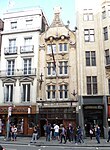Anglo-Belgian Club
1942 establishments in England2012 disestablishments in EnglandBelgian expatriates in EnglandBelgium–United Kingdom relationsBuildings and structures in the City of Westminster ... and 1 more
Gentlemen's clubs in London

The Anglo-Belgian Club (formerly the Royal Anglo-Belgian Club) was a private members' club located in Northumberland Avenue, London.
Excerpt from the Wikipedia article Anglo-Belgian Club (License: CC BY-SA 3.0, Authors, Images).Anglo-Belgian Club
Northumberland Avenue, London Covent Garden
Geographical coordinates (GPS) Address Nearby Places Show on map
Geographical coordinates (GPS)
| Latitude | Longitude |
|---|---|
| N 51.506944444444 ° | E -0.12611111111111 ° |
Address
Northumberland House
Northumberland Avenue 8
WC2N 5BY London, Covent Garden
England, United Kingdom
Open on Google Maps









